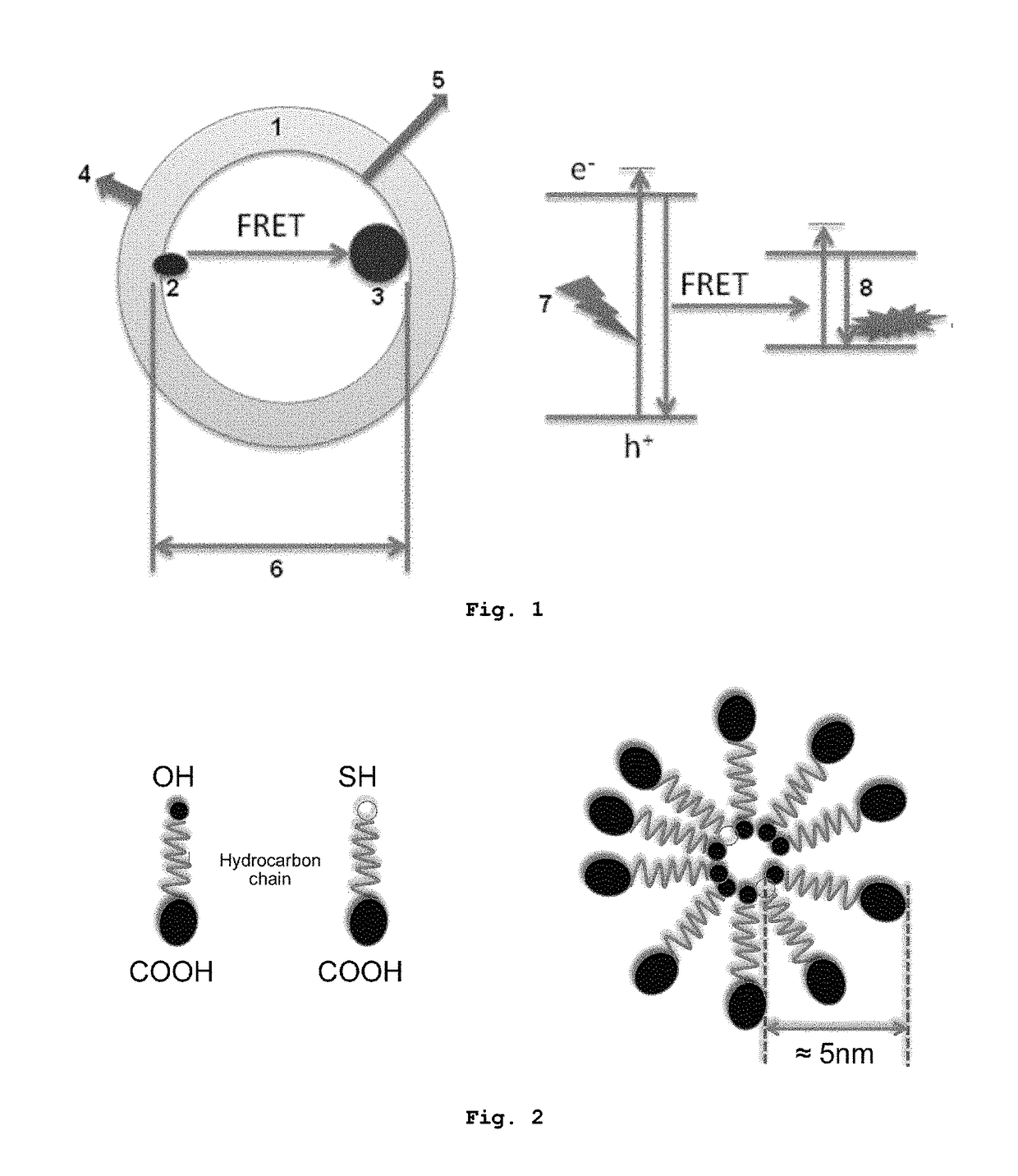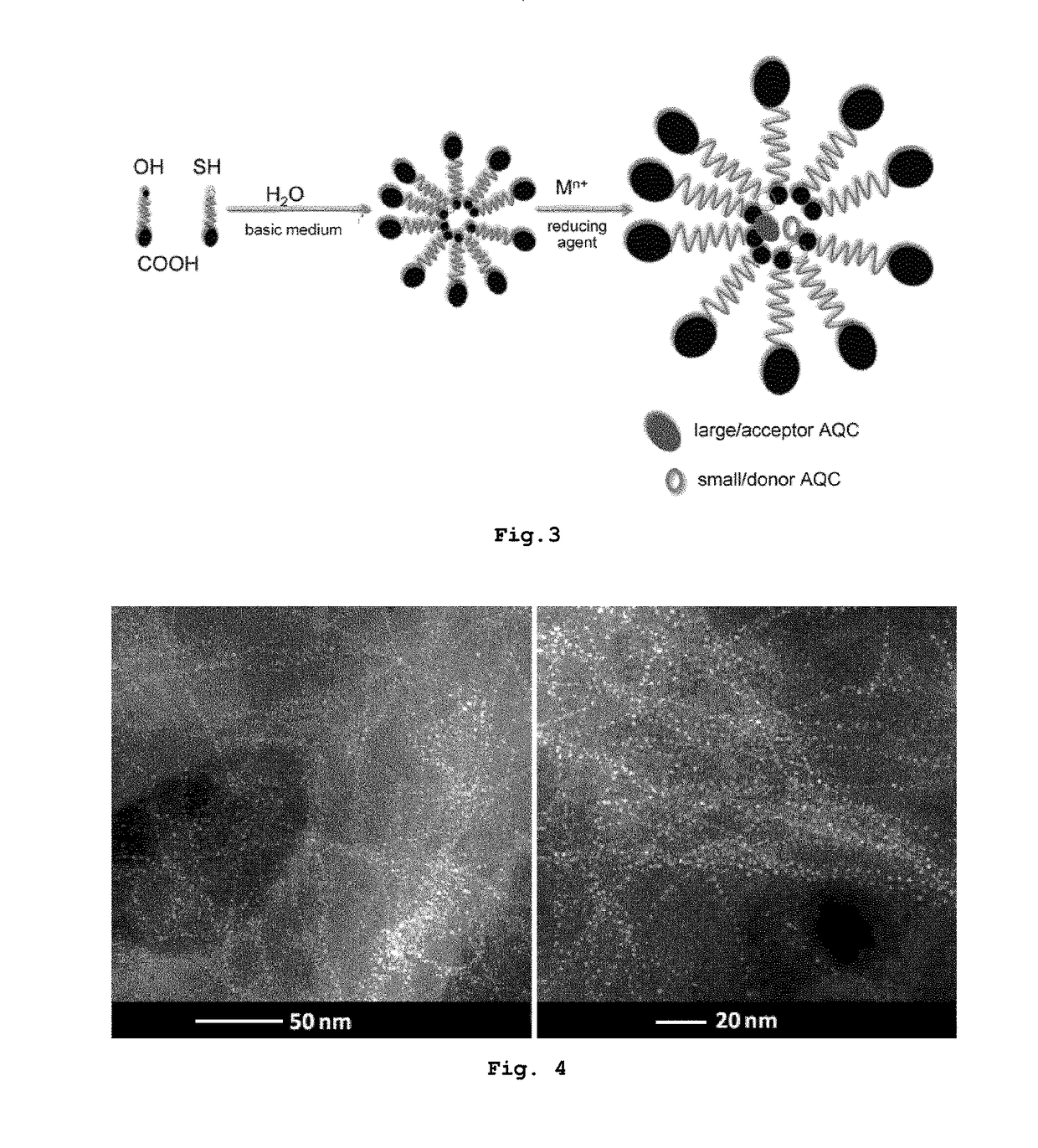Use of luminescent nanosystems for authenticating security documents
a luminescent nanosystem and security document technology, applied in the field of nanosystems, can solve the problems of difficult forging security documents, expensive and scarce materials, etc., and achieve the effect of preventing deactivation of luminescence, particularly of fluorescence, and long fluorescence decaying times
- Summary
- Abstract
- Description
- Claims
- Application Information
AI Technical Summary
Benefits of technology
Problems solved by technology
Method used
Image
Examples
example 1
of Gold AQCs Nanosomes with a Stokes Shift of 300 nm
[0149]For this example the method schematically depicted in FIG. 3 was followed.
[0150]An aqueous solution of the 16-hydroxypalmitic acid (2 ml, 10 mg / ml) was mixed with an aqueous solution of 16-mercaptopalmitic acid (0.622 ml, 10 mg / mL) with vigorous stirring in 5.4 ml of water and the necessary volume of tetrabutylammonium hydroxide until producing a basic mean. A volume of 400 μL of HAuCl4.3H2O (Au (III) chloride hydrate, metal base at 99.999%, Aldrich) (5.8 mg / ml) solution was added to the resulting solution of nanosomes with subsequent reduction by means of adding 400 μL of a NaBH4 solution (0.05 M). For the concentrations used, the values of R1 and R2 are 3.7 and 3.4, respectively. This gold nanosome stock solution was stirred at 35° C. for 1 hour. In order to purify the nanosomes containing the clusters, it is precipitated by adding acetic acid 0.5 M up to pH 7.8 and centrifuged to separate the solid containing excess reagen...
example 2
Synthesis of Au AQCs Nanosomes with a Stokes Shift of 370 nm
[0151]In order to achieve a Stokes shift greater than that described in Example 1, it is necessary to reduce the size of the acceptor clusters and to increase that of the donors. As described in the specification this is achieved by increasing the values of R1 and R2 with respect to the values used in Example 1. The selected values in this example were R1=4.1 and R2=4.3. It then proceeded in the following manner. An aqueous solution of 16-hydroxypalmitic acid (2.52 ml, 10 mg / mL) was mixed with the aqueous solution of 16-mercaptopalmitic acid (0.622 ml, 10 mg / mL) with vigorous stirring in 4.9 ml of water and the necessary volume 5 of tetrabutylammonium hydroxide until neutralization. A volume of 360 μL of a solution of HAuCl4.3H2O(Au (III) chloride hydrate, metal base at 99.999%, Aldrich) (5.8 mg / ml) was added to the resulting solution of nanosomes with subsequent reduction by means of adding 400 μL of a NaBH4 solution (0.05...
example 3
of Ag AQCs Nanosomes
[0152]Firstly, stock solutions of 16-mercaptopalmitic acid and 16-hydroxypalmitic acid are prepared at a concentration of 10 mg / ml, a given volume of tetrabutyl ammonium hydroxide solution (1.5 M in water) is added to ensure a molar ratio of fatty acid / TBAOH of 1. Then nanosomes are prepared mixing a given volume of each fatty acid stock solution with 25 ml of pure water (3.11 ml of 16-mercaptohexadecanoic acid and 10 ml of 16-hydroxyhexadecanoic acid).
[0153]In a second step, a stock solution of 0.0147 M AgNO3 is prepared in pure water. Then 2.7 ml of this solution is poured in the nanosome sample. An extra amount of TBAOH solution is added to the mixture to ensure redispersion of the material. Then, 2.7 ml of a freshly prepared stock solution of 0.05 M NaBH4 is added to the sample dropwise under vigorous agitation. The reaction is finished after 1 hour stirring at 35° C. in a thermostatted bath.
PUM
| Property | Measurement | Unit |
|---|---|---|
| inner diameter | aaaaa | aaaaa |
| decaying time | aaaaa | aaaaa |
| decaying time | aaaaa | aaaaa |
Abstract
Description
Claims
Application Information
 Login to View More
Login to View More - R&D
- Intellectual Property
- Life Sciences
- Materials
- Tech Scout
- Unparalleled Data Quality
- Higher Quality Content
- 60% Fewer Hallucinations
Browse by: Latest US Patents, China's latest patents, Technical Efficacy Thesaurus, Application Domain, Technology Topic, Popular Technical Reports.
© 2025 PatSnap. All rights reserved.Legal|Privacy policy|Modern Slavery Act Transparency Statement|Sitemap|About US| Contact US: help@patsnap.com



